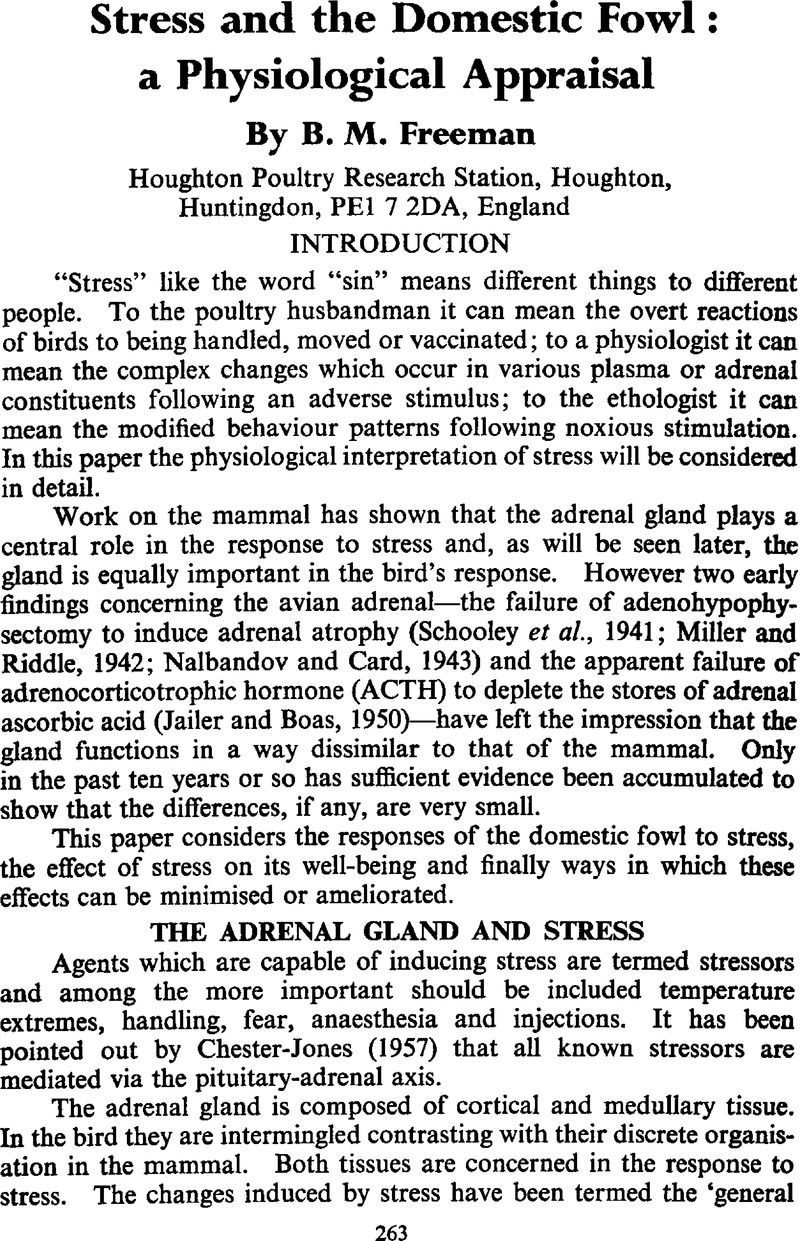Crossref Citations
This article has been cited by the following publications. This list is generated based on data provided by Crossref.
Bareham, J.R.
1972.
Effects of Cages and Semi-Intensive Deep Litter Pens on the Behaviour, Adrenal Response and Production in Two Strains of Laying Hens.
British Veterinary Journal,
Vol. 128,
Issue. 3,
p.
153.
Brown, Keith I.
and
Nestor, Karl E.
1974.
2. Implications of Selection for High and Low Adrenal Response to Stress.
Poultry Science,
Vol. 53,
Issue. 4,
p.
1297.
Wood, D.F.
and
Richards, J.F.
1975.
Effect of Some Antemortem Stressors on Postmortem Aspects of Chicken Broiler Pectoralis Muscle.
Poultry Science,
Vol. 54,
Issue. 2,
p.
528.
Roland, D.A.
Rowland, L.O.
and
Harms, R.H.
1975.
Reproductive Performance of Aged Layers Translocated from Cage to Floor.
Poultry Science,
Vol. 54,
Issue. 3,
p.
912.
Nir, I.
Waites, G. M. H.
and
Cunningham, F. J.
1975.
Obesity induced by force‐feeding and accompanying changes in body temperature and fertility in the male domestic fowl.
British Poultry Science,
Vol. 16,
Issue. 5,
p.
505.
Bareham, J.R.
1975.
Research in Farm Animal Behaviour.
British Veterinary Journal,
Vol. 131,
Issue. 3,
p.
272.
Freeman, B. M.
Manning, A. C. C.
Harrison, G. F.
and
Coates, Marie E.
1975.
Dietary Aureomycin and the response of the fowl to stressors.
British Poultry Science,
Vol. 16,
Issue. 4,
p.
395.
Nir, I.
Yam, D.
and
Perek, M.
1975.
Effects of Stress on the Corticosterone Content of the Blood Plasma and Adrenal Gland of Intact and Bursectomized Gallus Domesticus.
Poultry Science,
Vol. 54,
Issue. 6,
p.
2101.
Mukherjee, T. K.
Major, F.
Tawfik, E. S.
and
Horst, P.
1976.
Effect of stress on the quantitative levels of certain enzymes in mice.
Zeitschrift für Tierzüchtung und Züchtungsbiologie,
Vol. 93,
Issue. 1-4,
p.
48.
Freeman, B.M.
1976.
Stress and the Domestic Fowl: A Physiological Re-Appraisal.
World's Poultry Science Journal,
Vol. 32,
Issue. 3,
p.
249.
Burckhardt, Charlotte
and
Fölsch, Detlef W.
1977.
Serologische, Hämatologische und Andere Labormässige Untersuchungswerte als Parameter für die Belastung Unterschiedlich Gehaltener Hennen-Eine Diskussion der Literatur.
p.
26.
Kashani, M.
Salimi, M. M.
and
Zamani, M.
1977.
On the use of some phenothiazine derivatives in chickens.
British Poultry Science,
Vol. 18,
Issue. 6,
p.
723.
SIMENSEN, E.
OLSON, L.D.
VANJONACK, W.J.
JOHNSON, H.D.
and
RYAN, M.P.
1978.
Determination of Corticosterone Concentration in Plasma of Turkeys Using Radioimmunoassay.
Poultry Science,
Vol. 57,
Issue. 6,
p.
1701.
Harvey, S.
and
Phillips, J.G.
1980.
Growth, growth hormone, and corticosterone secretion in freshwater and saline-adapted ducklings (Anas platyrhynchos).
General and Comparative Endocrinology,
Vol. 42,
Issue. 3,
p.
334.
Siegel, H. S.
1980.
Physiological Stress in Birds.
BioScience,
Vol. 30,
Issue. 8,
p.
529.
SIMENSEN, E.
and
OLSON, L.D.
1980.
Upper Lethal Environmental Temperature in Turkeys.
Poultry Science,
Vol. 59,
Issue. 11,
p.
2578.
PIERSON, FRANK W.
HESTER, PATRICIA Y.
and
WILSON, ELLEN K.
1981.
The Effects of Chronic Handling on the Incidence of Leg Abnormalities and Several Blood Parameters in Turkeys.
Poultry Science,
Vol. 60,
Issue. 6,
p.
1333.
Harvey, S.
Klandorf, H.
and
Phillips, J. G.
1981.
Effect of food or water deprivation on circulating levels of pituitary, thyroid and adrenal hormones and on glucose and electrolyte concentrations in domestic ducks (Anas platyrhynchos).
Journal of Zoology,
Vol. 194,
Issue. 3,
p.
341.
DUNCAN, IAN J.H.
1981.
Animal Rights – Animal Welfare: A Scientist's Assessment.
Poultry Science,
Vol. 60,
Issue. 3,
p.
489.
Duncan, I. J. H.
1981.
Research and Development in Relation to Farm Animal Welfare.
p.
39.



